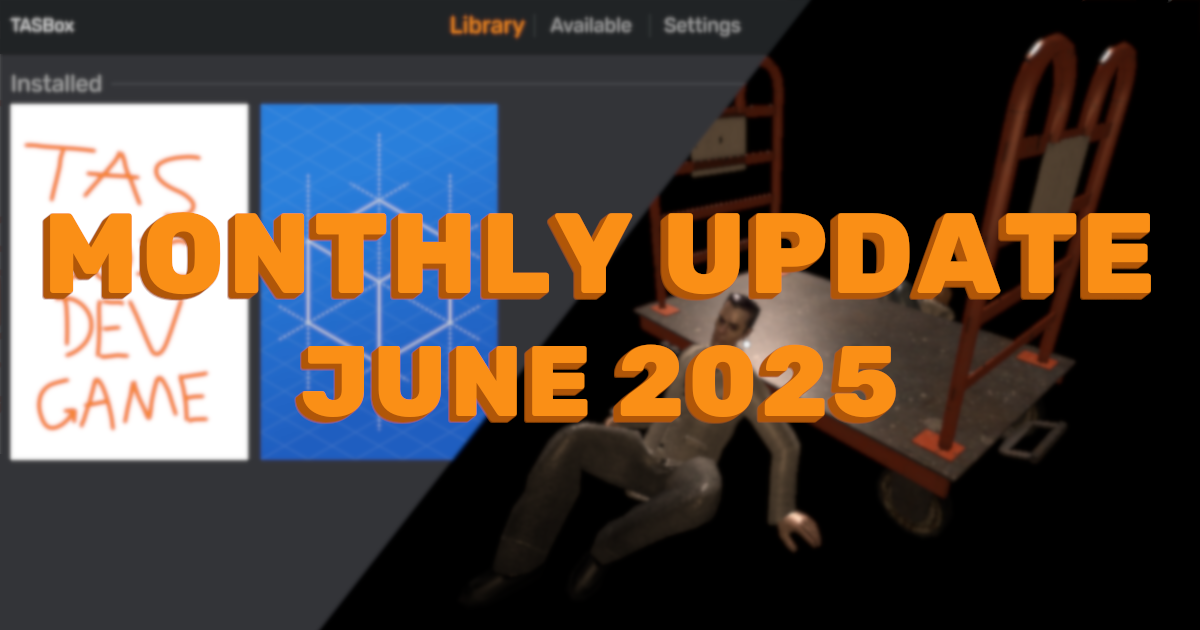Monthly Update - June 2025
User interfaces, graphical improvements, our own language and more of PhysX exposed to Lua - Here's what's been happening in TASBox this month 🚀

Foreword
The first installment of what I hope to make a regular monthly development update, covering any significant changes that have happened during the month.
Lots has happened since the last blog post, and we're almost at the point where building simple physics-based games and addons is practical.
There's still a long way to go until TASBox is ready for a closed playtest, but it's really starting to take shape.
User Interface
Since the last post I've primarily worked on building almost fully custom UI rendering into TASBox. Where many sandbox games out there opt to use web renderers (CEF, Awesomium, Ultralight, etc.), I didn't want the increased overhead and possibility for vulnerabilities that integrating a browser engine entails.
What I've gone with I think people will really like, especially if you're coming from React/Solid.js:
def { .Container, .Text } = UI
def Button = UI.createComponent(fn(props, children)
fn() {
Container({
.onClick = props.onClick,
.style = {
.fontSize = 30,
.backgroundColour = Colour.fromHex("#FFF"),
.cornerRadius = 10,
.padding = 5,
},
.styleHovered = {
.backgroundColour = Colour.fromHex("#DDD")
}
}, fn() { children } end)
} end
end)
def App = UI.createComponent(fn()
def count, setCount = State.createSignal(0)
fn() {
Container({
.style = {
.fontSize = 30,
.textColour = Colour.fromHex("#FFA010"),
.alignY = UI.ChildAlignment.Centre,
.gap = 10,
.padding = 10,
}
}, fn() {
Text({ "Count is: ", count }),
Button({ .onClick = fn() setCount(count() + 1) end }, fn() {
Text({ "Increment" })
} end)
} end)
} end
end)
UI.render(App, UI.SCREEN)
This simple example will render a counter, and display the incremented count every time the user clicks the button (image).
We've already used this framework to build an initial main menu, as a sort of launcher where you can view and play your installed games:
MoonJuice
Another major change is the introduction of our own functional programming-oriented language to fill some gaps in Luau's feature set, and provide a more ergonomic experience when working with TASBox's APIs. The name comes from a combination of Lua and Elixir, the two languages which inspired it.
You can see a great example of the syntax above for the UI example, so I won't repeat it here. Instead, here's a list of the key features in MoonJuice at the moment:
- Interoperates with Luau seamlessly - Include Lua scripts from MoonJuice and vice versa
- Transpiles to Luau
- Table unpacking:
def { .foo, .bar = baz } = { .foo = 1, .bar = 2 } - Implicit returns - Last expression of a code block implicitly returns its value
- Everything* is an expression:
def x = if someCondition then 1 else 2 end - Pipe operator:
someVariable |> fnWithOneParam |> fnWithTwoParams("secondParam")
*Some small exceptions, such as def for variable declaration
There's a lot more that I want to do with MoonJuice (such as a JSX-style syntax for UI), and there's still some bugs / core missing features, but we're already using it for the majority of package code in place of Lua because it's so much nicer to write.
Graphical Improvements
A bit of a smaller change than the previous two in terms of dev effort and getting us towards the playtest, but I think people will really appreciate it:
I got sick of looking at the dull dot-product diffuse shading we had as a placeholder, so I decided to port my BSDF from VisTrace. I won't bore you with the details of how it works (maybe I'll write a dedicated blog post on it at some point), but it's what gives the realistic looking specular and diffuse lighting in the video above.
The BSDF by itself wasn't really selling it though, so I added extremely rudimentary ambient lighting by taking a second sample in the surface normal's direction. This avoids the even less realistic and dim look we were getting from a single distance light.
A contribution from PotatoOS is also visible above, which is the addition of normal map support providing a more visually detailed surface on any assets which have the texture.
Physics API Additions
Last but certainly not least, we have a few updates to physics in TASBox.
Character Controllers
The PhysX kinematic character controller library has been exposed to Lua, allowing you to create characters which interact with the 3D world:
Scene Queries
All three types of scene queries in PhysX - raycast, sweep and overlap - have been exposed too. This lets you build weapons, character interactions and more by performing intersection tests with the scene using rays and shapes.
Here's a demo using a sphere sweep query to apply force to whatever entity the player is looking at when they press the left mouse button:
Articulations for Ragdolls
The internal representation of ragdolls in the physics simulation has changed from rigid bodies + joints to reduced coordinate articulations. This provides much greater simulation stability for the ragdoll's joints, especially when under extreme stress as in the video below:
